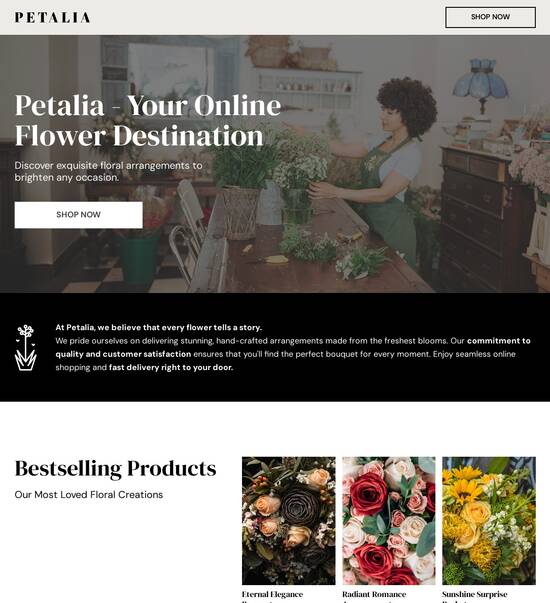
Pricing page template for Fintech
Explore Similar TemplatesAbout template
Discover our vast library and find your perfect pricing page template for Fintech. See how easy it is to improve your conversions with Instapage!
Recommended templates

Easy to build without coding
With the intuitive drag-and-drop builder, anyone on your team can create high-converting pages without any knowledge of code or design. Make enhancements to your landing page with custom widgets using Javascript, HTML/CSS, or third-party scripts.

Multiple layouts for any industry and goal
Select from 500+ landing page layouts built to boost conversions across industry-specific scenarios. Customize them by adjusting fonts, adding images, and generating on-brand content with the AI assistant. Quickly scale with Instablocks® and Global Blocks that you can save, reuse, and update globally.

Loads fast and looks polished on any device
Every template is responsive, which means they present professionally on any device and load blazingly fast with our Thor Render Engine. You can also power them up with Google AMP technology to deliver an unparalleled mobile experience and drive higher conversions.

Robust analytics & experimentation
Get real-time updates and reporting across all your devices, showing the number of visitors, conversions, cost-per-visitor, and cost-per-lead. Launch AI-powered experiments, run A/B tests, and use heatmaps to analyze user behavior, then optimize your landing page to maximize conversions.







Easy to build without coding
With the intuitive drag-and-drop builder, anyone on your team can create high-converting pages without any knowledge of code or design. Make enhancements to your landing page with custom widgets using Javascript, HTML/CSS, or third-party scripts.
Multiple layouts for any industry and goal
Select from 500+ landing page layouts built to boost conversions across industry-specific scenarios. Customize them by adjusting fonts, adding images, and generating on-brand content with the AI assistant. Quickly scale with Instablocks® and Global Blocks that you can save, reuse, and update globally.
Loads fast and looks polished on any device
Every template is responsive, which means they present professionally on any device and load blazingly fast with our Thor Render Engine.
Robust analytics & experimentation
Get real-time updates and reporting across all your devices, showing the number of visitors, conversions, cost-per-visitor, and cost-per-lead. Launch AI-powered experiments, run A/B tests, and use heatmaps to analyze user behavior, then optimize your landing page to maximize conversions.
All the features you need to build lead-generating landing pages
Explore more featuresLearn how to build top-performing landing pages for any goal
FAQs
Leading the way in building high-performing landing pages





An effective step-by-step guide to using Instapage for landing page optimization
Creating effective landing pages is crucial for maximizing ROI in digital marketing campaigns. Instapage's robust platform provides the necessary tools for marketers looking to accelerate their performance and optimize user engagement. This guide will detail the steps involved in creating high-converting landing pages using Instapage.
Understanding your audience
Before diving into creating your landing page, it’s essential to understand your target audience. Marketers in sectors like education, financial services, and SaaS need to tailor their messaging and design to resonate with their specific customer profiles. Conducting audience research helps identify pain points and preferences.
- Identify demographic characteristics. Understanding age, gender, location, and interests can significantly impact your messaging.
- Analyze user behavior. Knowing how your audience interacts with your content can guide the design and layout of your landing pages.
- Gather feedback. Use surveys and social media to directly connect with your audience and gather insights into their needs and preferences.
Utilizing Instapage's templates
Instapage offers over 100 ready-made templates designed for high conversions. These templates are customizable, allowing users to adapt them according to their needs without requiring technical skills.
- Choose a template. Select a design that aligns with your campaign objectives and industry standards.
- Customize elements. Modify the text and images to better represent your brand and messaging.
- Leverage built-in lead generation elements. Use forms and CTAs designed to maximize conversions.
Optimizing for conversion
To ensure that your landing pages convert effectively, utilize Instapage’s built-in optimization tools. These features provide insights and allow for A/B testing.
- Conduct A/B tests. Regularly test different elements like headlines, images, and CTAs to see what drives better results.
- Utilize heatmaps. Analyze user interactions on your pages to determine where visitors are clicking and how they are navigating.
- Assess your performance analytics. Use the dashboard to understand traffic and conversion metrics, enabling ongoing optimization.
Effective landing pages combine strategic design, audience understanding, and continuous optimization. Instapage simplifies this process, allowing marketers to create impactful campaigns.
In conclusion, leveraging Instapage’s powerful features allows you to scale your marketing efforts effectively and maximize ROI. Start creating your landing pages today to see the results firsthand.
Ready to optimize your digital marketing campaigns? Sign up for Instapage and start building high-converting landing pages that captivate your audience.
The evolution of pricing pages in fintech: A template for success
Understanding the importance of pricing in fintech
Pricing is a critical component of any fintech company's strategy, directly impacting profitability, customer acquisition, and retention. Various pricing strategies, such as subscription models, tiered pricing, and pay-as-you-go structures, can be utilized to meet diverse consumer needs. An effective pricing page serves as the first point of engagement for potential customers, showcasing the value proposition of the services offered and streamlining decision-making through clarity and transparency.
One major challenge facing fintech pricing is the often-complex nature of financial products, which can confuse potential customers. Compounded by the need for regulatory compliance and the high level of competition, creating a straightforward and compelling pricing page is more important than ever. The pricing page must perform the dual function of enticing customers while also building trust, ensuring that price points reflect the quality and reliability of the services offered.
Key elements of an effective fintech pricing page template
To create an impactful pricing page, there are several key elements to consider. The first of these is clearly defined pricing tiers, allowing users to easily understand the different options available. Each tier should include comprehensive descriptions of services, so customers know exactly what they will receive at each price point. Implementing a user-friendly design is also crucial; the layout should guide users toward making a decision without overwhelming them with too much information.
Clearly defined pricing tiers provide options that are easy to compare.
Transparent service descriptions enhance understanding of what each pricing tier includes.
User-friendly design principles involve clean layouts and intuitive navigation.
Additionally, incorporating trust signals, such as customer testimonials, security badges, and compliance logos, helps establish credibility. These elements assure potential customers of the company’s reliability and adherence to industry standards. Lastly, an effective visual hierarchy ensures that users can quickly locate important information, making the pricing page more engaging.
Showcase features of revolutionary pricing templates
Modern pricing templates are rapidly evolving. Dynamic pricing models, for instance, allow flexibility for various service options and can incorporate usage-based pricing strategies tailored to customer needs. This adaptability is a significant advantage in a sector where customers expect the ability to only pay for what they use. By integrating these features, fintech companies can offer more personalized and relevant pricing.
User dashboards can enhance the customer experience by providing real-time insights. Customers can track their usage and costs directly from their dashboard, fostering a sense of control over their finances. Interactive pricing calculators are also essential, especially when dealing with complex pricing structures. They empower potential customers to model scenarios specific to their needs, simplifying the decision process.
Crafting compelling service descriptions
An effective pricing page not only outlines costs but also highlights unique value propositions. It is essential to differentiate services in the competitive fintech landscape, providing users with clear examples of tangible benefits. Service descriptions must go beyond mere features; they should present an attractive narrative around how these features solve customer problems or meet specific needs.
Highlight unique selling points to differentiate from competitors.
Provide concrete examples that illustrate the value offered.
Use visual comparisons, such as tables, to clarify pricing structures.
While tables are effective for visual representation, descriptive lists can also serve their purpose. Choosing the right format depends on what best conveys the information. Testing different approaches can provide valuable insights into which format most resonates with target users.
The user journey: From launch to subscription
Mapping the customer experience from the moment they land on the pricing page until they subscribe is crucial for understanding their journey. This involves crafting a seamless navigation experience that guides them through the available options and consistently prompts calls to action. Coherent navigation that leads customers further into the purchasing funnel can significantly improve conversion rates.
A/B testing is an effective technique to optimize pricing pages continuously. By experimenting with various designs, layouts, and messages, companies can gather data about which elements drive conversions and which do not. Real-world case studies demonstrate that such testing can lead to remarkable improvements, providing a clear framework for ongoing optimization.
Strategies for enhancing trust and credibility
To build a trust-focused content framework, fintech companies should consider including diverse content types that bolster credibility. This could include customer reviews, transparent pricing breakdowns, and relevant case studies. Scaling efforts that enhance understanding can impact customer trust positively and improve overall conversion rates.
Include customer testimonials and reviews to provide social proof.
Ensure transparency in pricing breakdowns to enhance trust.
Use partnerships and affiliations with respected organizations to increase credibility.
Strategic partnerships can significantly impact trust levels. Demonstrating collaboration with recognized organizations not only adds to credibility but can also enhance brand reputation by association. Several fintech firms have successfully leveraged such partnerships, resulting in increased customer confidence and loyalty.
Development of customizable pricing templates for diverse fintech products
Customization is fundamental when developing pricing templates for a range of fintech products. Specialized templates can be tailored for specific niches, such as investment apps or lending platforms, to meet unique user needs. Successful companies often incorporate feedback from users to refine these templates over time, ensuring they remain relevant and effective.
Create specialized pricing templates catering to unique niches.
Gather user feedback to continuously iterate and improve templates.
Ensure flexibility in templates to adapt to shifting market demands.
The role of creators in this development process cannot be overstated. Their commitment to integrating user feedback shapes the pricing landscape, enabling them to meet customer expectations more effectively. By focusing on user needs, fintech innovators can craft tailored pricing solutions that resonate within their respective markets.
Future trends in fintech pricing pages
As technology evolves, the integration of AI and machine learning into pricing strategies is becoming more prevalent. These innovations enable fintech companies to offer personalized pricing experiences tailored to individual user behaviors and preferences. Anticipating these changes will be crucial as they shape the future customer experience.
AI can facilitate personalized pricing models that adapt to user behavior.
Machine learning will help predict user needs and optimize pricing strategies.
Subscription-based models are anticipated to continue gaining traction in the fintech industry.
The shift toward subscription-based models indicates a broader trend towards monthly or annual pricing structures. As this model continues to gain acceptance, understanding user perceptions will be pivotal for companies looking to thrive in a competitive landscape. Embracing and anticipating the preferences of customers will play a vital role in shaping pricing strategies in the fintech sector.
Conclusion: The future of pricing pages in fintech
In summary, the evolution of pricing pages in fintech is crucial as industry players seek to enhance their service offerings and improve customer engagement. By embracing innovative templates, companies can better serve their customers and stand out in an increasingly crowded marketplace. The ongoing transformation of customer needs and expectations emphasizes the importance of continually optimizing pricing pages to deliver a seamless user experience.
Ready to skyrocket conversions?
Supercharge your ad campaigns with high-performing landing pages
Get started














